Deep in the heart of Crete lie mountainous regions which divide the northern part with the southern part. These mountains are the main reason why Crete has remained so undeveloped in the greater part. There are little villages nestled in the folds of these ranges which do not form part of the known tourist routes. Located away from the sea, they are little known and hardly accessible to the tourists, as bus routes do not go there.
View Larger Map
The Argiroupoli Springs are located just beyond the Prefecture of Hania, in the Lappa region of Rethimno.
View Larger Map
The Argiroupoli Springs are located just beyond the Prefecture of Hania, in the Lappa region of Rethimno.
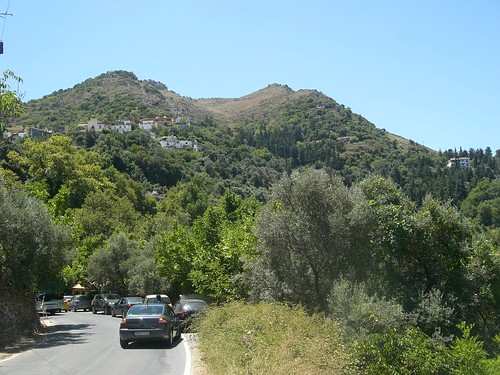
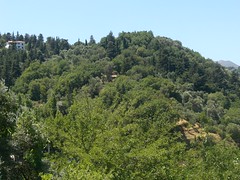
When the signs on the road begin to welcome you into the Prefecture of Rethimno, turn right at the village of Episkopi, and don't stop till you find the sign for the Argiroupoli Springs. This village doesn't give away.

As you drive into the area, you will notice that it is quite arid looking; the roadside is filled with tinder dry grasses. This is surprising given the spring waters which the area contains. Lush vegetation is found where these waters spill over man-made waterfalls, but the fields close by all look as though they need to be irrigated. The residential areas lack a canopy of trees, leaving their rooftops exposed to the harsh summer heat.
Google 'Aryiroupoli Rethimno' (using various spellings of both words) and you'll find lots of information about the significance of the area - something about an ancient site called Lappa, created by Agamemnon, allies with Knossos, and of special significance in Roman and Byzantine times. Some very important archaeological digs have taken place here, but this is not the crowd puller nowadays: Aryiroupoli is popular with locals and tourists (who hire a car or come on coach trips) for its natural springs. The water has been routed to create mini-waterfalls, around which tavernas have been built, bringing in the crowds right throughout the spring, summer and autumn (in the winter, it is too cool to sit so close to the water). This phenomenon makes Aryiroupoli a cool retreat in contrast to baking under the sun on a hot sandy beach (which is only less than a quarter of an hour away from the village).
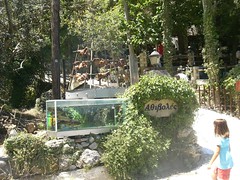
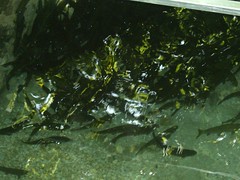
All the restaurants in the area use the spring waters to raise trout, which can be ordered freshly cooked on the grill. We managed to secure the best position near the waterfall.
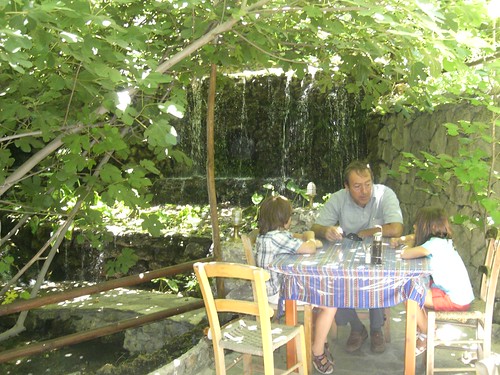
On a hot day, you just want to be near the water. The Aryiroupoli springs are an off-the-beaten-track alternative to the sea and sand culture of a Cretan summer holiday.
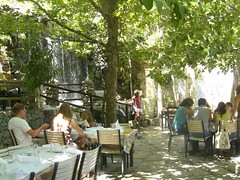
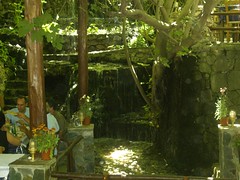 ,
,The tavernas serve mainly local traditional meals. The Rethimno area - and most of Eastern Crete - is known for its use of an upright barbecue grill, known as 'antikristo' in Greek, used to roast lamb and pork (I much prefer the traditional grill myself - the meat needs longer cooking time on the antikristo and the fire creates excess heat in an excessively hot summer atmosphere). Another specialty of the area is freshly grilled trout (the combined smells of meat and fish can be off-putting); the springs run into catchment tanks where trout is bred exclusively for the tavernas.
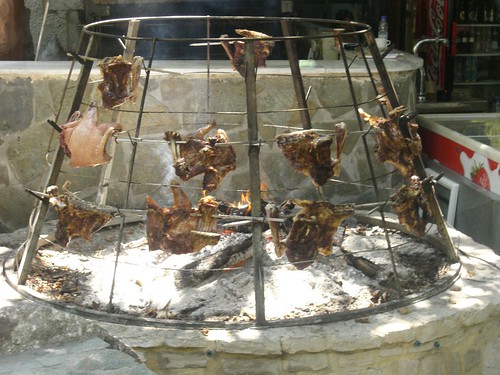
The antikristo barbecue grill isn't commonly seen in Hania; it's a specialty of most other parts of Crete.
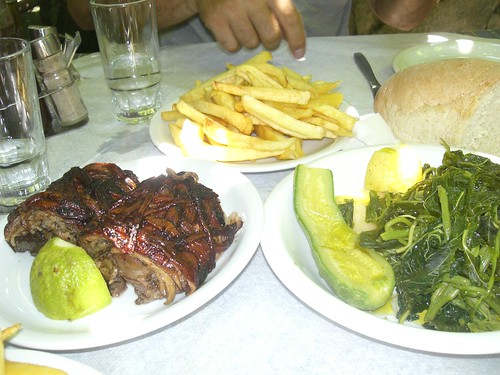
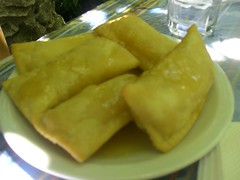
Kokoretsi (offal wrapped round intestines and grilled on the spit) was on the menu of Ellanion Fos Taverna where we chose to sit, perfectly positioned by the waterfalls. Vlita (amaranth) is the summer horta variety. It's a healthier alternative to the common Greek salad. We chose kalitsounia (those Rethimniotes were trying to pass them off for mizithropites) drizzled with honey for dessert.
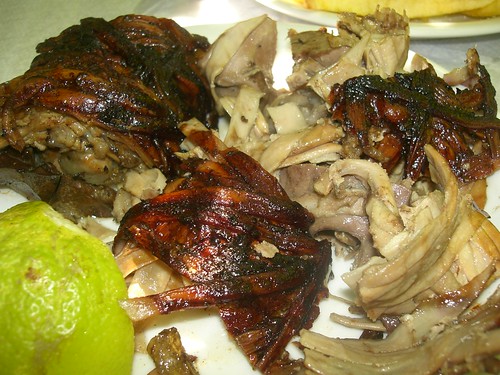
We also ordered a serving of antikristo lamb (sorry about the photo) and stuffed bifteki.
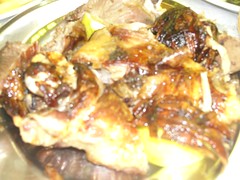
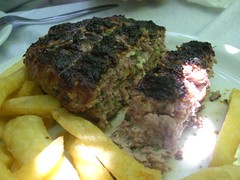
We were entertained by a Romanian musical troupe who was touring the area, going from one taverna to the other. They must have had insider knowledge of the area (not to mention transport facilities) to know where the crowds were today. They played three songs, then went round the tables collecting donations in the tambourine .
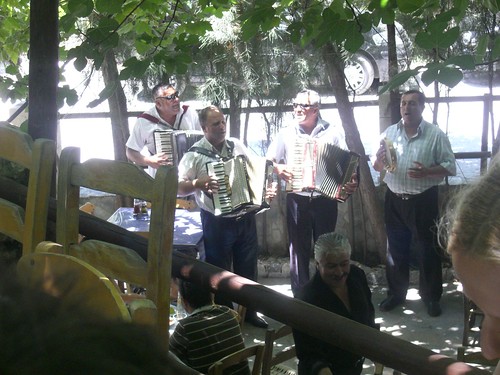
Take a look at the burly black-shirted chap (the taverna owner) in the foreground. He has the typical Cretan looks: height and bulk, dark facial features with piercing blue eyes, premature grey hair. Compare him with a couple of other typical looking Cretans: my dad and Alex.
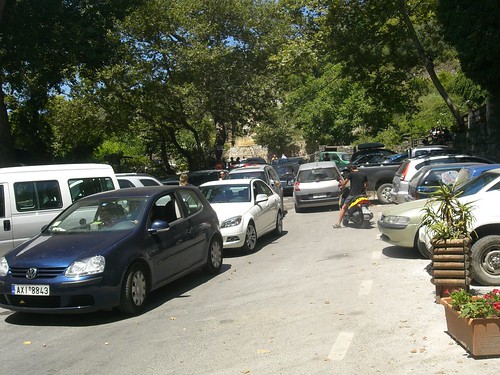
Be sure to get to the area early for prompt service without too many hassles, as most Greeks like to arrive at the same time just after 1pm, slowing down service considerably after that point. We beat the rush and ate our lunch leisurely over two hours, leaving just after two o'clock, the time when the hordes of Athenian travellers who had just begun their summer holidays were arriving (as well as two double-storeyed coaches), creating a traffic jam in the narrow windy streets of the village. We had parked at the entrance to the village, knowing well what we would find if we tried to park right outside the taverna, a common Greek trait (to secure a parking spot right outside the place you want to go, especially since Greeks have a love affair with their four wheeled possessions). No one could move forward or back at that point, bringing a bit of chaos to the place, but we wouldn't be Greeks if we didn't live up to the meaning of the word; after all, we invented it, didn't we?
For the four of us, we ordered a serving each (for two) of antikristo lamb and kokoretsi, stuffed bifteki, two servings of fried potatoes, vlita salad, fried cheese pies (mizithropites) with honey, 2 tap beers (plus 2 more) and 2 lemonades. Cost - 48 euro (we couldn't eat it all in one go, so we took the leftovers home).
©All Rights Reserved/Organically cooked. No part of this blog may be reproduced and/or copied by any means without prior consent from Maria Verivaki.
For the four of us, we ordered a serving each (for two) of antikristo lamb and kokoretsi, stuffed bifteki, two servings of fried potatoes, vlita salad, fried cheese pies (mizithropites) with honey, 2 tap beers (plus 2 more) and 2 lemonades. Cost - 48 euro (we couldn't eat it all in one go, so we took the leftovers home).
©All Rights Reserved/Organically cooked. No part of this blog may be reproduced and/or copied by any means without prior consent from Maria Verivaki.
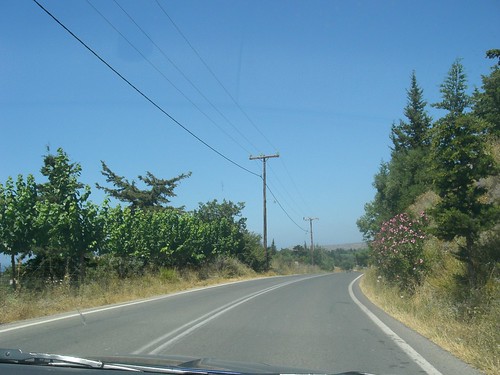

Fun! Sounds and looks like a great place to visit.
ReplyDeleteThanks Greeks, for inventing chaos. Haha good one!
And thanks for the link to Etymology Dictionary.
This place sounds lovely and "drosero" to beat those hot days! You had me in hysterics about the car parking scenario. It's so true!
ReplyDeleteSounds glorious.
ReplyDeleteRoll on August 15th!
ReplyDeleteIt looks like a lovely spot, and it sounds like a great way to have fresh trout!
ReplyDeleteWhat a serene place and what an unusual bbq! I have never seen it anywhere in Greece, so it has to be a Cretan invention...
ReplyDeleteI enjoyed this post very much. This is how I like to spend my holidays, exploring the countryside and tasting genuine, rustic food.
ReplyDeleteIt looks a wonderful place!
ReplyDeleteThe landscape, the trout in the spring waters in the restaurant, the set up seem too familiar to me! In Turkey, I haven't seen meat being cooked this way though. What a great outing with your family.
ReplyDeleteYour family doesn't go out for dinner that often but when you do...boy you sure pick'em well!
ReplyDeleteI love the Anti-Christ grill, the meat looks fabulous and the venue, under the cool naturally shade of trees...perfect.
The countryside is so beautiful, Maria. This would be a great outing and I would love to order fresh trout at that restaurant!
ReplyDelete